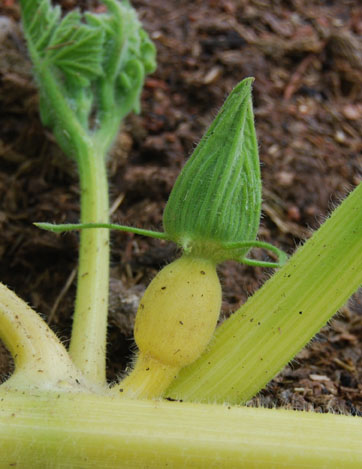To tell if a female pumpkin flower is pollinated, look for a small fruit forming at the base of the flower within a week of blooming. Additionally, observe if the flower wilts and drops off the plant.

Credit: www.reddit.com
Indicators Of Successful Pollination
One way to tell if a female pumpkin flower is pollinated is by observing the blossom wilting and dropping off. This happens when the flower has been successfully fertilized and pollination has occurred. Another indicator is the growth of the fruit behind the flower. After successful pollination, the base of the flower will swell, indicating the start of fruit development. As the pumpkin grows, it is important to keep an eye on the development of the baby pumpkin. If it continues to grow and mature, it is a sign that the flower was successfully pollinated.
| Blossom wilting and dropping off | Indication of successful fertilization and pollination |
| Growth of the fruit behind the flower | Sign of fruit development after pollination |
| Development of baby pumpkin | Confirmation of successful pollination |
Identifying Unpollinated Flowers
One way to tell if a female pumpkin flower has been pollinated is by looking for the lack of fruit growth. If the flower has not been pollinated, it will remain small and not develop into a fruit. Another sign is wilted blossoms with no fruit behind them. These flowers will typically wither away without producing a pumpkin.
Additionally, an unpollinated flower may have a shrinking appearance, indicating that it has not been fertilized. By monitoring the growth and development of the flowers, you can determine if the female pumpkin flowers have been successfully pollinated.
How to Tell If Female Pumpkin Flower is Pollinated: Step by Step Guide
Factors Affecting Pollination
Factors affecting pollination include inadequate pollinator activity, poor weather conditions, and a lack of male flowers nearby. When it comes to pollination, having enough pollinators present is crucial. Plants rely on pollinators, such as bees, butterflies, and birds, to transfer pollen from the male flowers to the female flowers. However, if there is not an adequate number of pollinators in the area, the chances of successful pollination decrease.
Poor weather conditions can also impact pollination. Rain, wind, and extreme temperatures can disrupt the process by preventing pollinators from flying or causing the flowers to close up. These conditions can make it difficult for pollen to be transferred effectively between flowers, ultimately leading to inadequate pollination.
In addition to pollinators and weather, the proximity of male flowers to female flowers plays a role in successful pollination. Female pumpkin flowers rely on male flowers for pollination, as the male flowers produce pollen. If there are no male flowers nearby or if they are not flowering at the same time as the female flowers, pollination will not occur.
Hand-pollinate Pumpkin Flowers
- Identifying male and female flowers: Female pumpkin flowers can be distinguished by the small fruit that starts to develop at their base. Male flowers, on the other hand, have a slender stem with no fruit.
- Collecting male flower pollen: Gently pluck a male flower from the plant, being careful not to damage it. Remove the petals to expose the stamen, which contains the pollen.
- Transferring pollen to female flowers: Select a female flower that is fully open and receptive to pollen. Take the stamen with the collected pollen and gently rub it on the female flower’s stigma, located in the center of the flower.
Hand-pollination is a useful technique for ensuring successful pumpkin fruit production. By following these steps, you can easily tell if a female pumpkin flower is pollinated and increase the chances of a bountiful harvest.
Common Mistakes In Hand-pollination
In the process of hand-pollination, it is crucial to avoid common mistakes to ensure successful pollination of female pumpkin flowers. One common mistake is using a dirty or contaminated brush. It is important to use a clean and sterile brush to transfer pollen to avoid any contamination that may affect the pollination process.
Another mistake to avoid is transferring pollen between unrelated pumpkin varieties. Cross-pollination between unrelated varieties may result in undesirable traits in the offspring. It is important to keep track of the varieties being hand-pollinated and ensure that pollen from the same variety is used.
Additionally, overpollinating or underpollinating the flowers can also lead to poor results. Overpollination may cause stress on the plant, leading to reduced fruit development. On the other hand, underpollination may result in poor fruit set or even no fruit at all. It is important to find the right balance while hand-pollinating to ensure optimal fruit development.
Maximizing Natural Pollination
Attracting pollinators to the garden is crucial for a successful pumpkin harvest. Create a pollinator-friendly environment by planting a variety of flowers with different bloom times. Flowers like lavender, zinnias, and sunflowers are particularly attractive to bees and butterflies. Provide a source of water, such as a shallow dish with rocks for insects to land on and drink.
Timing the planting of pumpkin varieties is also important. Make sure to plant your pumpkin seeds when there is a consistent temperature above 70°F (21°C) during the day. This will help ensure that there are plenty of warm days for pollinators to be active in your garden. Additionally, planting multiple varieties of pumpkins with staggered planting dates can help extend the pollination period.
Remember, a well-pollinated female pumpkin flower will have a small fruit developing at its base. If you notice that the flower wilts and falls off without any fruit forming, it may not have been successfully pollinated. By implementing these tips, you can increase the chances of successful pollination for your pumpkin plants.
Recognizing Infertility Issues In Pumpkin Flowers
Recognizing infertility issues in pumpkin flowers is crucial for successful pollination and fruit set. Signs of sterile or infertile flowers can include their failure to produce fruit, lack of visible pollen, or absence of female reproductive organs. Factors such as plant stress and nutrient imbalances can contribute to female flower infertility. Stressors like extreme temperatures, inadequate moisture, or poor soil conditions can inhibit proper flower development and pollination. Nutrient deficiencies, especially in micronutrients like boron or zinc, can also affect flower fertility.
Properly addressing these stressors and nutrient imbalances through soil testing, fertilization, and moisture management is essential to increase the chances of successful pollination. In some cases, seeking professional guidance from a horticulturist or agronomist might be necessary, particularly when persistent fertility issues occur despite adjustments made in cultivation practices. By recognizing and addressing infertility issues, pumpkin growers can improve their chances of achieving abundant fruit set and a bountiful harvest.
Frequently Asked Questions Of How To Tell If Female Pumpkin Flower Is Pollinated
How Can You Tell If A Female Pumpkin Flower Is Pollinated?
One way to tell if a female pumpkin flower is pollinated is by looking at its appearance. A pollinated flower will start to develop a small fruit at the base of the flower. Additionally, you can also check for signs of wilting or drying up, as this can indicate that the flower was successfully pollinated.
What Happens If A Female Pumpkin Flower Is Not Pollinated?
If a female pumpkin flower is not pollinated, it will eventually wither and fall off the plant. Without pollination, the flower is unable to develop into a fruit. This is why it is important to encourage pollination in your pumpkin plants to ensure a successful harvest.
How Long Does It Take For A Female Pumpkin Flower To Become Pollinated?
The process of pollination in female pumpkin flowers usually takes around one to two days. During this time, bees and other pollinators transfer pollen from the male flowers to the female flowers, resulting in successful pollination. Keep an eye on your plants to catch the pollination process in action.
Why Are Female Pumpkin Flowers Important For Fruit Production?
Female pumpkin flowers are important for fruit production because they contain the ovaries that, when pollinated, develop into the pumpkins we harvest. Without successful pollination of the female flowers, the plant will not be able to produce fruit. Ensuring proper pollination is essential for a bountiful pumpkin harvest.
Conclusion
Being able to identify if a female pumpkin flower is pollinated is crucial for successful pumpkin gardening. By observing the physical characteristics and changes in the flower, such as the appearance of a swollen ovary or the withering of the petals, gardeners can determine if pollination has occurred.
This knowledge allows them to take necessary steps to ensure the growth and development of healthy pumpkins. Happy gardening and may your pumpkin patch be bountiful!

